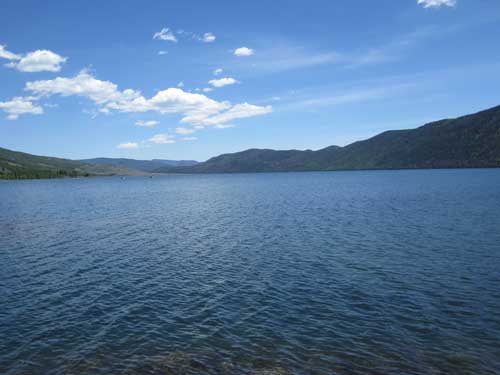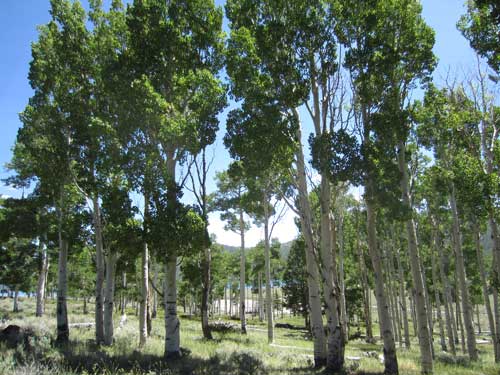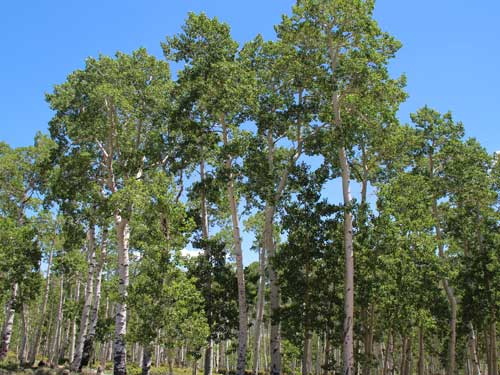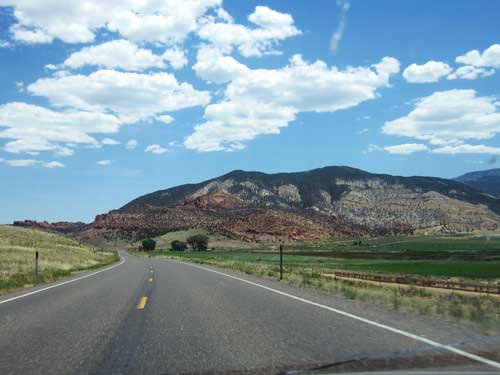CAPITOL REEF (Day 23 - part 3)
Instead I decided to leave the park and drive somewhere cooler... up to Fish Lake, which was also home to the world's most massive living organism!! My drive took me from the sheer red cliffs up into the steep green mountains. I thought the lake was only 20 miles away. It turns out it was 50.


This monolith is known as the Egyptian Temple.



The gradual shift from red...



... to green.

The object of my quest was Pando... an enormous grove of quaking aspens that is considered to be a single organism. But how can a whole bunch of different trees be considered one giant plant?
While many trees spread through flowering and sexual reproduction, quaking aspens usually reproduce asexually via a process called suckering. An individual stem (tree) can send out lateral roots that send up other erect stems. From above ground, the new stems look just like individual trees. But they aren't. The process can be repeated until a whole grove forms. This collection of multiple stems all form a single, genetic individual... usually termed a clone.
Pando (Latin for 'I spread') is a clonal colony of a single male quaking aspen, determined to be a single living organism by identical genetic markers and assumed to have one massive underground root system. The colony encompasses 106 acres, weighs around 13 million pounds (making it the heaviest known organism), and has over 40,000 stems. As individual stems die, they are replaced by new stems growing from its roots. The average age of Pando's stems is 130 years, but the roots are estimated to be 80,000 years old (making it among the oldest known living organisms as well). The world’s largest organism, however, is considered to be a thousand-acre fungal mat in Oregon.
How does such a thing happen? Pando is thought to have grown for much of its lifetime under ideal circumstances. Frequent forest fires prevented conifers (its main competitor) from taking over, and a climate shift from wet and humid to semi-arid has hindered rivalry from other younger aspens.
But there were aspens all over the mountainsides. Which one was it? I went into the marina store at the lake and ask. The girl said that unfortunately the area was closed off.
Apparently, Pando is struggling. While the mature stems routinely die from the eternal problems of pests and drought, the regenerative roots that are responsible for the organisms resilience are in trouble. The main reasons seem to be overgrazing by deer and elk and years of fire suppression. Without young stems to replace older trunks, Pando is vulnerable to a catastrophic, sudden withering and shrinking. In an attempt to help, approximately 67 acres of the grove have been fenced off. Treatments are being used to stimulate regeneration of young aspen. These include burning (to remove undergrowth), cutting (to allow sunlight for new shoots), and the ripping up of roots (to stimulate suckering).
I was disappointed but understood. So I decided to do a hike around the lake as a consolation.

Fish Lake (once known as Wahsatch Lake) is best known for its sport fishing (especially for large lake trout known as mackinaw) and there were trucks, trailers and boats everywhere. There was even a fish cleaning station.

The lake is 6 miles long and one mile wide with its deepest spot being 175 feet.
I took the hiking trail to the south, hoping to make my way up to the overlook. Unfortunately after only 10 minutes, a giant fence cut across the trail, closing the area off. There was no detour around it; I was simply going to have to turn back.


The Old Spanish Trail stretched 1,200 miles from Santa Fe (New Mexico) to the village of Los Angeles (in the Mexican Territory of California). This was a 72-mile shortcut which reached elevations of almost 9,000 feet.

From 1829 to 1848, traders used this pack trail to carry New Mexican woolen goods (rugs, blankets, etc) in exchange for California mules and horses.


End of the road

As I dillydallied at the fence, I began to look more closely at the trees... they were covered with scars! There was not a single tree left unscathed. Some had words; other had whole sentences; some wounds were old; some were brand new. It was exactly the same as back in Capitol Reef with the rocks. What was with this need to vandalize such incredible beauty!? My heart ached for each and every one of them.




Has this been truly going on since 1944?


Let's not forget all truly important messages.
I slowly made my way back to the trailhead.




Quaking aspens are named for their leaves, which flutter even in the slightest of breezes, producing a gentle rustling noise. With this in mind, it's easy to see why Pando's nickname is the Trembling Giant.
Feeling a bit thwarted, I started driving back. Suddenly I think I found Pando! And while I couldn't actually stand next to it, I could hang out with its neighbors across the street.


Fenced off... and in the right location...

...Pando, is that you??

The trees across the street were just as pretty... if you ignored all the scarring.

This guy needed a whole tree to himself!

Oh, and this guy had to do an even longer name!

But this has to take the cake! Thanks, Hodges family. The tree looks SO much better now. It was so dull before!
I began the steep drive back down from green to red.



While passing through Torrey, I decided to stop at the Capitol Reef Inn & Cafe for a bit of lunch. As I sat eating my delicious vegetarian lasagna, I realized I could just the 3 pm petroglyph talk... the very one I had missed yesterday! I quickly shuffled off.


return • continue

